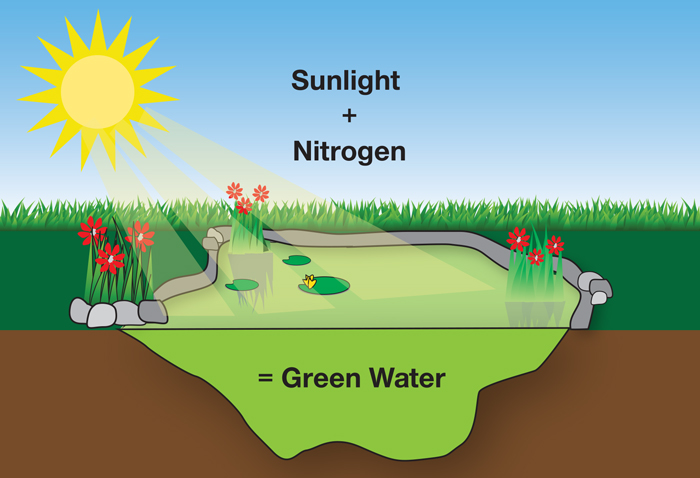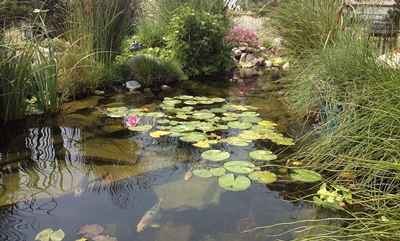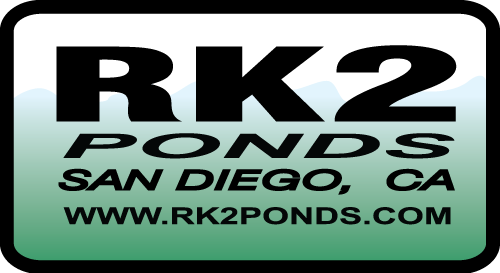Pond Green Algae
Algae Growth (Photosynthesis)
Kio ponds are usually closed recirculating aquatic systems, meaning that these systems, unlike natural ponds with streams flowing through them, lack a fresh water flow-through source. Rather, closed recirculating aquatic systems rely on filtration to purify and reoxygenate their water. Outdoor ponds that are closed systems are subject to seasonal algae blooms and attached filamentous algae growth due to nutrient and carbon dioxide buildup. Increased levels of nutrients and carbon dioxide create the potential for a healthy algae population.
Pigments (chlorophyll, fucoxanthin and carotenoids) in the algae absorb light energy and use it to convert carbon dioxide and nutrients into new cell biomass through photosynthesis. The primary nutrients of concern are nitrogen and phosphorus. Nitrogen is a by-product of decomposed fish waste, uneaten fish food and accumulated sludge in the bottom of the pond. View the Nitrification Process.

Planktonic Algae
Planktonic Algae are waterborne, single-cell algae, most commonly referred to as Green Water. Planktonic Algae (algae bloom) usually occurs as a result of increased levels of nutrients and carbon dioxide in pond water, combined with the energy of sunlight. Planktonic algae can be controlled with aquatic plants, shade, ultraviolet sterilization or chemical methods. Using aquatic plants as a algae control requires that a specific number of mature plants are added to the pond to compete with the algae for the available nutrients and carbon dioxide. Shade is available only if foliage or a shelter inhibits the pond's exposure to sunlight. Chemical treatments can be successful, but they can be expensive, temporary and potentially harmful to plants and fish.
The advantages of UV sterilization make it an attractive option for algae control.
- It is a physical treatment, so it does not change the water chemistry of the pond water
- The UV treatment (sterilization) takes place outside the pond
- It is not harmful to aquatic plants or fish
- It is very easy to install
Filamentous Algae
Attached filamentous algae can be seen growing on the rocks of a waterfall or on the sides of the pond. The growth of filamentous algae results from high levels of nutrients; carbon monoxide and the catalyst, the Sun's energy. Methods of controlling filamentous algae include increased shade, reducing the frequency of fish feedings, practical water changes and the use of chemicals or plecostomus (algae-eating fish) during the summer months. More information on filamentous algae can be found here
Algae Isn't Bad, Is It?
Algae can be either beneficial or detrimental to a pond, depending on the owner's viewpoint. Algae provide nutrients for newly hatched fry and indirectly act as a color enhancer. As algae grow in a pond a population of zooplankton will also develop, on which the fish feed. These natural live feeds help develop the intense coloration desired in most koi. Unfortunately, algae blooms prevent viewing the fish so sick fish can go undetected for days or even weeks.
Algae influence the water quality of the pond, mainly by affecting the balance among dissolved oxygen, pH, carbon dioxide and nutrients. During photosynthesis, algae produce oxygen, remove nutrients and take up respired carbon dioxide from both the fish and the algae itself. In heavily stocked ponds, the water becomes supersaturated with carbon dioxide. High levels of carbon dioxide can quickly depress the pH of the water to levels below seven if the operator is not careful to maintain proper alkalinity levels and adequate aeration for stripping. During active periods of photosynthesis (during daylight hours), algae can quickly strip the carbon dioxide out of the water and pH levels can rise above nine in a matter of hours. Fish not acclimated to such sharp shifts may initially show signs of stress.
At night, both algae and fish consume oxygen from and exhale carbon dioxide into the system. Algae compete with the fish for available oxygen in the water. A potentially serious impact of an algae bloom is the risk of an "algae crash" triggered by temperature or barometric pressure. When an algae bloom collapses, dead algae cells settle to the bottom of the pond adding to the decomposing sediment's oxygen demand. If the crash is severe, the pond's oxygen supply can be quickly depleted, endangering the fish, unless backup aeration is available. Additionally, as the dead algae cells rupture, they can release organic nitrogen and phosphorus back into the water adding to the system's nutrient load. The biological cycle starts again with bacteria converting the organic nutrients to inorganic elements. Which are then available to be recycled, and the algae bloom continues.

Practical Algae Control
View your pond as an ecosystem, one requiring you to manage it to maintain proper balance. Fish ponds without adequate plantings are most susceptible to algae bloom problems. These ponds are usually well stocked with overfed fish. The absence of aquatic plants eliminates competition with algae for available nutrients in the pond water. Practical fish stocking densities and feeding must be managed closely.
UV Sterilization is a proven method for controlling waterborne algae. Combining UV Sterilization with adequate mechanical filtration, and operating the two properly is most effective in eliminating algae blooms and maintaining clear water. This combination will not, however, control nitrogen or carbon dioxide levels. Practical fish stocking densities and responsible feeding, along with routine filter and UV Sterilizer maintenance play a big part in achieving a balanced system. Partial water changes (approximately ten percent of the pond volume weekly with non-chlorinated water) will aid in diluting nutrients. Filamentous algae may grow and will benefit the pond by consuming nutrients and carbon dioxide. Responsible fish feeding will encourage the fish to graze on the filamentous algae, which is good in their diet. Filamentous algae may also be harvested and used as a fertilizer in gardens; remove it by hand or with a long-bristle brush.

